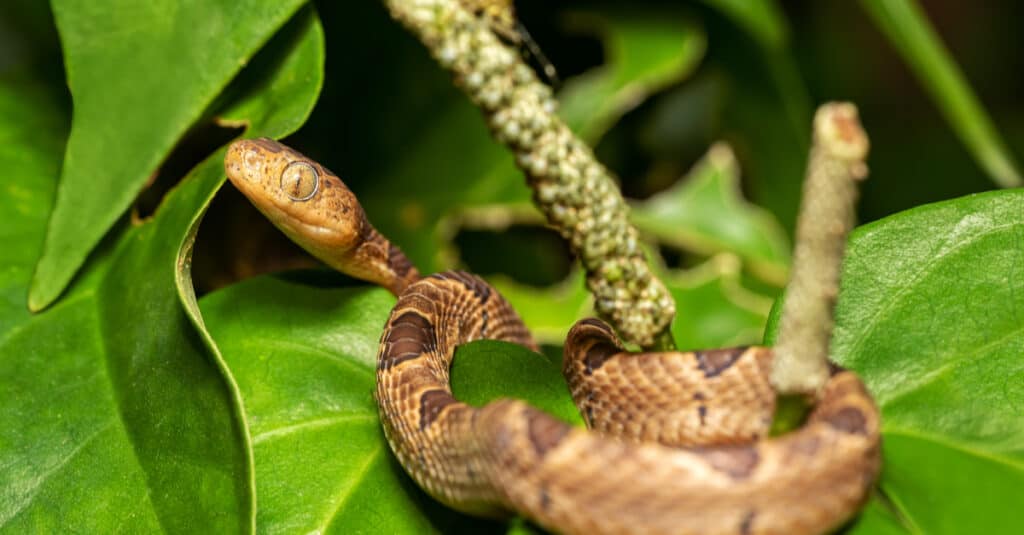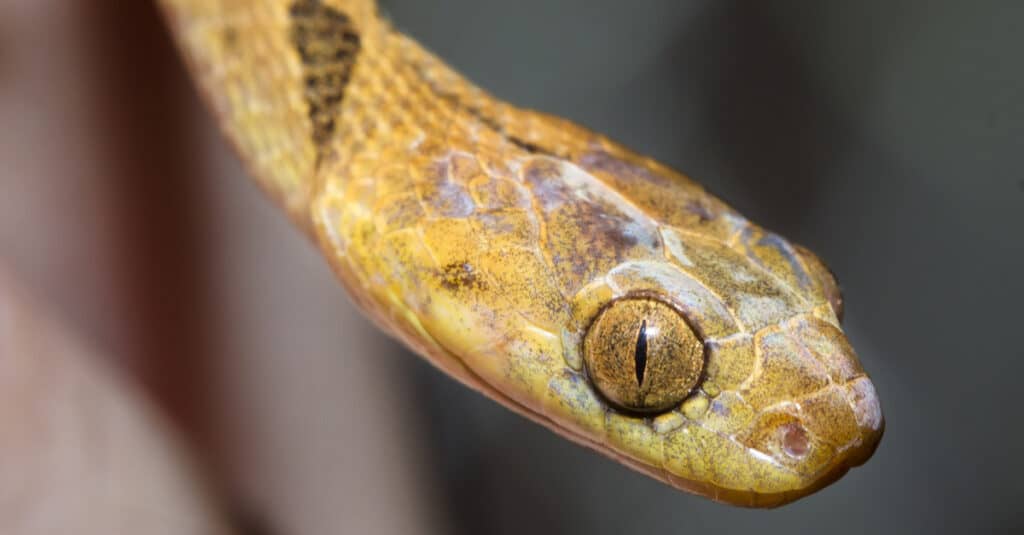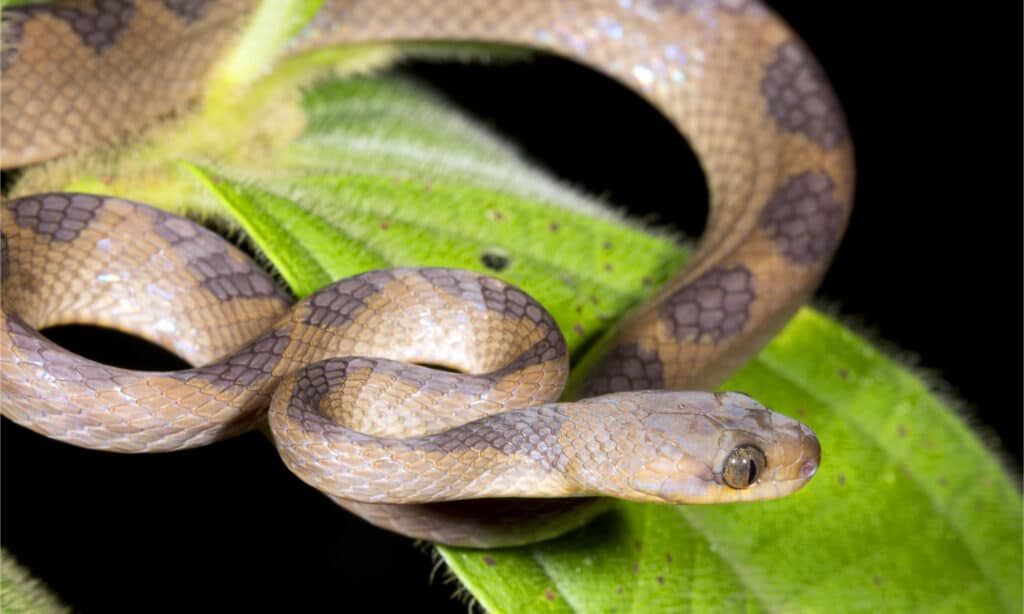Cat-Eyed Snake
Leptodeira annulata
Evidence indicates that females can delay fertilization and store sperm for later years to produce eggs even in the absence of contact with a male!
Advertisement
Cat-Eyed Snake Scientific Classification
- Kingdom
- Animalia
- Phylum
- Chordata
- Class
- Reptilia
- Order
- Squamata
- Family
- Colubridae
- Genus
- Leptodeira
- Scientific Name
- Leptodeira annulata
Read our Complete Guide to Classification of Animals.
Cat-Eyed Snake Conservation Status
Cat-Eyed Snake Facts
- Prey
- Frogs, lizards, salamanders, fish, and rodents
- Fun Fact
- Evidence indicates that females can delay fertilization and store sperm for later years to produce eggs even in the absence of contact with a male!
- Estimated Population Size
- Unknown
- Biggest Threat
- Habitat destruction and deforestation
- Most Distinctive Feature
- Huge eyes in relation to body size with vertical pupils that resemble a cat's
- Distinctive Feature
- Blotches or saddle patterns along the back
- Habitat
- Grasslands, scrublands, and rainforests throughout the Americas
- Diet
- Carnivore
- Common Name
- Cat-eyed snake
View all of the Cat-Eyed Snake images!
The cat-eyed snake is a genus of slender snakes with huge cat-like eyes.
There are between 12 and 16 recognized species within this genus. Some of the most common species include the northern cat-eyed snake, banded cat-eyed snake, and rainforest cat-eyed snake. The name of this genus is easily confused with the cat snakes (including the Egyptian cat snake), which are a member of the same family but not the same genus. Besides their size and color pattern, the main difference is that cat-eyed snakes are only found in the Americas. In order to narrow the focus of this article, only the species of the genus Leptodeira will be mentioned.

5 Amazing Facts
- Cat-eyed snakes generally breed once a year. After copulating, the female lays a clutch of up to 12 eggs. There is some evidence females can delay fertilization and store sperm for later years to produce eggs even in the absence of contact with a male. The juveniles hatch up to three months later by piercing through the shell with an egg tooth. The mother gives no other parental care after the juveniles have hatched.
- These snakes primarily rely on their sense of smell to detect the world around them, including the scent of prey and snake pheromones. Like many other types of snakes, they have a unique organ located on the roof the mouth. When they flick out their tongues, they gather scent molecules from the air and bring them to organ in the mouth.
- Cat-eyed snakes completely lack the ability to hear, but their ear structure does give them the ability to detect vibrations in the ground.
- These snakes snakes are nocturnal hunters. The vertical pupils may help them accurately judge the distance of prey, especially at night. They probably have difficulty seeing stationary objects though.
- Cat-eyed snakes continue to grow throughout most of their lives. However, the lifespan of these snakes has never been properly documented in the wild.

A Banded Cat-Eyed Snake uses its tongue to sense information about prey and its environment.
©fivespots/Shutterstock.com
Where to Find Them
Cat-eyed snakes are found in many different environments, including grasslands, scrublands, and rainforests, throughout the Americas. They live as far north as Texas and as far south as Argentina but are most commonly found in Mexico and Central America, including the common banded and northern cat-eyed snakes. They prefer to seek out areas with plenty of cover along the ground to hide under from dangerous predators.

Cat-eyed snakes are found in many different environments, including grasslands, scrublands, and rainforests, throughout the Americas.
©Artush/Shutterstock.com
Scientific Name
The scientific name of cat-eyed snake is Leptodeira. It’s not entirely clear where this name originated from, but it may be related to the ancient Greek word lepto, which means thin or narrow. Confusingly, there is another genus called the Malagasy cat-eyed snakes which are found exclusively on the African island of Madagascar. They are part of an entirely separate family and not closely related to the Leptodeira genus at all.
Population and Conservation Status
The population numbers of the cat-eyed snake have never been properly estimated, but according to the IUCN Red List, every single species is ranked as least concern. This is the best possible classification. It means that numbers are likely high and the species require no special conservation efforts. The northern cat-eyed snake is probably the most common and widespread. The greatest threats are probably habitat destruction and deforestation, which eliminates their natural cover.
Appearance and Description
The cat-eyed snakes are characterized by a long, slender body that can stretch up to 5 feet. By far the most conspicuous feature is the a. Depending on their age and geographical location, they come in a variety of different colors, including brown, pale gold, and reddish-orange with large dark markings or saddle shapes along the back. These snakes belong to a group called the rear-fanged snakes. As the name suggests, the fangs are located at the back of the jaw. Females are ever so slightly larger than males on average, but for the most part, they are very difficult to tell apart from each other.
Here is how to identify the cat-eyed snake:
- A long, slender body stretching up to 5 feet.
- Large eyes with vertical pupils.
- Blotches or saddle patterns along the back.
- Brown, tan, pale gold, or reddish-orange skin color.

Cat-eyed snakes have huge eyes in relation to body size with vertical pupils that resemble a cat’s.
©Kevin Wells Photography/Shutterstock.com
History and Evolution
Like other snakes, the historic ancestors of Cat-eyed Snakes roamed the land on legs, as surprising as that may be. They had legs just like other reptiles like lizards, turtles, and crocodiles. At some point in their evolution and millions of years ago, prehistoric snakes found it advantageous to not use their legs as much and crawl low to the ground or perch in trees. Eventually, their legs became unused and unnecessary. You can see vestigial legs on some snake species today as evidence.
Cat-eyed Snakes have in common that they have vertical pupil adaptation. This feature has helped them hunt at night and judge distances more accurately to help them not only hunt but also avoid any unwanted enemies.
How Dangerous Are They?
The cat-eyed snake is capable of producing low-toxicity venom that should have minimal effects on people. At worst, if you’re bitten, you may experience some mild pain and swelling. You may want to contact your doctor just out of precautionary care, but you should expect to experience no long-term effects. The position of its fangs at the back of the mouth actually makes it difficult for these snakes to bite easily. You would have to seriously antagonize it before it would bite out of self-defense.

The cat-eyed snake is capable of producing low-toxicity venom that should have minimal effects on people.
©Dr Morley Read/Shutterstock.com
Types of Cat-eyed Snakes
As mentioned there are over a dozen types of Cat-eyed snakes. Here are a few:
- Northern Cat-eyed Snake – These can be found in Ecuador, Panama, and Columbia.
- Banded Cat-eyed Snake – Also called the Cat-eyed Night Snake, these snakes are found in South America, Central America, and in a few places in the Caribbean. They prefer habitats in forests, marshes, and swamps.
- Rainforest Cat-eyed Snake – Also called the Mayan Cat-eyed Snake, these reptiles can be found in Belize, Guatemala, and Mexico.
- Aruban Cat-eyed Snake – These snakes can be found in Venezuela and Aruba, of course. They are also called Baker’s Cat-eyed Snakes.
- Southwestern Cat-eyed Snake – This subspecies calls Mexico its home.
- Small Spotted Cat-eyed Snake – This group is located in Costa Rica, Mexico, Belize, Nicaragua, El Salvador and Guatemala.
- Splendid Cat-eyed Snake – With the best name on the list, this subspecies can be found in Mexico.
- Uribe’s Cat-eyed Snake – The last one on our list can also be found in the country of Mexico.
Behavior and Humans
The cat-eyed snake is not very aggressive at all. If encountered by a person, they will attempt to run away and hide. Only when they’re cornered will they coil up their bodies and threaten to strike. It is always best just to leave them alone. If you need to pick one up, then they should be handled with care.
View all 235 animals that start with CCat-Eyed Snake FAQs (Frequently Asked Questions)
Are cat-eyed snake venomous?
Yes, the cat-eyed snake does have a mild form of venom that only affects smaller prey, not humans.
How do cat-eyed snake hunt?
The cat-eyed snake is primarily a nocturnal hunter. They will come out at night and begin actively searching for food. If the prey is small enough to fit in its mouth, then the snake will swallow it whole. If the prey is too large, however, then the snake will try to hold the animal in its jaws and attempt to position it at the back of the throat to puncture it with the fangs and deliver its venom. When the prey is sufficiently paralyzed, the snake will consume as much of the prey as it can.
Are cat-eyed snake aggressive?
They are not aggressive at all toward people.
Where do cat-eyed snake live?
The cat-eyed snake can survive in many different habitats, including grasslands and rainforests. They prefer areas with lots of cover along the ground.
What do cat-eyed snake eat?
The diet of the cat-eyed snake changes depending on the location and the season, but most species tend to eat frogs, lizards, salamanders, fish, and rodents.
What does a cat-eyed snake look like?
The cat-eyed snake has a long, slender body up to 5 feet from head to tail, but they do not look intimidating at all. They are easily distinguishable from other snakes by their vertical cat-like eyes. Colors and body patterns are likely to vary quite a bit by species.
Why is it called a cat-eyed snake?
It is called a cat-eyed snake because of the vertical cat-like pupils.
What are the predators of the cat-eyed snake?
The cat-eyed snake is preyed upon by various types of hawks and falcons. During the day, they prefer to hide under logs, leaf litter, and other debris for protection. If they encounter a predator, then they will usually choose to run away and hide than bite. Some species can also emit a foul-smelling substance to distract predators. Their drab color schemes provide a natural means of camouflage against the ground as well.
What is the difference between a cat-eyed snake and a cat snake?
Cat snake is the informal name for any species within the genus Telescopus and also Boiga. Examples include the Egyptian cat snake and the banded cat snake. They are also called Old World cat snakes because they’re primarily found in Eurasia and Africa. For instance, the Egyptian cat snake is found throughout northeastern Africa. There are many similarities between cat-eyed and cat snakes. Like the cat-eyed snake, their eyes have the vertical feline shape because of their similar nocturnal lifestyle, but their appearance does vary in subtle ways as well.
Thank you for reading! Have some feedback for us? Contact the AZ Animals editorial team.
Sources
- Animal Diversity / Accessed April 8, 2022
- The University of the West Indies / Accessed April 8, 2022
- The Online Guide to the Animals of Trinidad and Tobago (1970) https://Leptodeira_annulata%20-%20Cat-eyed%20Snake%20or%20False%20Mapepire.pdf / Accessed April 8, 2022


















